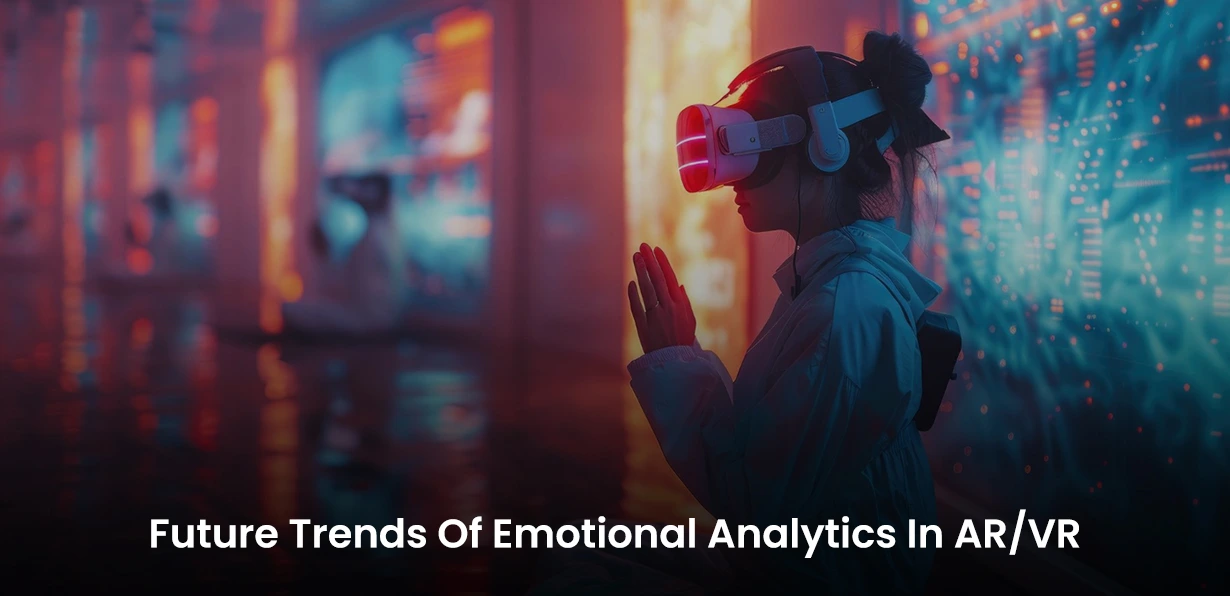Future Trends Of Emotional Analytics In AR/VR
In the present time one of the biggest emerging fields is the technology of emotional analytics combined with augmented reality and virtual reality. The more we go deeper into embracing innovation, the real-time analysis and interpretation of human emotions become core. This blog looks at the future of emotional analytics in augmented and virtual reality and its application in various sectors like entertainment, education, health, and many others. Let’s dive into this together and know more about the same.
Understanding About Emotional Analytics
Emotional analytics is a process of dealing with data analysis pertaining to the determination and understanding of people’s feelings. It can be done through facial recognition or voice, biometric sensors, and even machine learning that scans user interactions. When it comes to the use of AR and VR, these approaches can dynamically tailor interface interactions based on the user’s feelings and, therefore, increase participation.
Identification of emotions in the context of virtual reality (VR) is an exciting problem area that deals with the intersection between computer science and psychology. With the future developments in VR, recognizing the signs of emotions in this virtual reality setting starts to become significant in improving the user’s experiences depending on tasks such as gaming, therapies, and social interactions.
Understanding Emotional Cues
In traditional formats, people use nonverbal cues like facial expressions, body posture or gestures, and voice intonation to identify emotions. In VR, these cues can be magnified and, at the same time, can be hidden. The faces of characters, or avatars, are also distorted, which ultimately can express emotions more vividly than in reality. For example, in a scene, the smile is wide, or the eyebrows are lined, indicating joy or anger, respectively. Still, such signals could differ in the range of observed cultural variations and interindividual differences and should be discussed while considering the context.
Leveraging Technology
VR technologies can also include real-time emotion recognition, which is a system that detects facial emotions in real-time. There are some VR systems, especially those utilizing cameras and sensors, that are designed to examine the users’ facial expressions and overall movements. These technologies can pick even the slightest of shifts in expressions and body position, making the system responsive.
For instance, if a user seems tense or distressed, the VR experience can adjust—maybe offering a calming environment or prompting the user to take a break. This responsive approach can enhance immersion and help users feel more connected to the virtual world.
Avatars and Empathy
Emotion display and recognition represent major concerns that are highly relevant to avatars for VR interfaces. Identifications will be made later in part about how others perceive emotions based on these representations, such as one’s avatar, which is often employed to substantiate users’ identities. For instance, a user might select an avatar that looks happy and friendly, and this can have an impact on mood-making. On the other hand, an aggressive-looking avatar might make the others feel threatened. Such interplay of perception underscores the need to design avatars in a manner that would lead to positive affective communications.
Non-Verbal Communication
All the communication that one gets an opportunity to practice in the real world has a chance of being displayed in VR. Both vocal expressions and nonverbal cues such as gestures, body posture and positioning, and the distance between two people can help express emotions. For instance, when a woman curls her body forward, it may mean that she is interested or excited compared to when she crosses her arms because this implies she is uncomfortable. Users can learn not only to recognize such cues in themselves but also in other people, thus increasing empathy while interacting in virtual environments.
Context Matters
The emotional context in which the VR experience should be staged is relevant to the recognition of emotions. A horror game is likely to trigger feelings of fear and anxiety or stress, while a puzzle game played in the spirit of a team-building activity is likely to promote team spirit and happiness. Such an understanding assists the users with the ability to better handle their feelings. Also, people’s emotions can be associated with the place: quiet nature can make individuals feel calm while presenting noise and confusion can disturb them.
Feedback and Reflection
Last but not least, feedback is beneficial to identifying emotions in a VR context. After the task, the users should have the chance to think about their feelings. Encouraging debriefing sessions or emotional checks and balances can assist users in putting emotions into words and identifying what causes the reaction. This ability not only increases one’s real-life self-analysis but also promotes personal emotional development, thus explaining why virtual reality is a great tool for emotional learning.
In a Nutshell
This blog has stated how you can make use of artificial intelligence and bring the whole technology to life with emotions. Nettyfy Technologies understands all the emotional cues and is also focusing on the avatars to leverage the emotional concerns. We offer dedicated support and will consistently be available to address your questions or issues, providing mental tranquility throughout your project. So, without further ado, reach out to us today.


